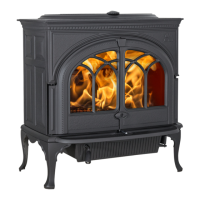Prefabricated Chimneys
If a prefabricated metal chimney is to be used it must be
a chimney type that is tested and listed for use with solid
fuel burning appliances.
That means a chimney that is tested to the following:
High Temperature (HT) Chimney Standard UL 103 for
the U.S. and High Temperature Standard ULC
S-629 for Canada.
The manufacturers installation instructions must be
followed precisely. Always maintain the proper
clearance to combustibles as established by the pipe
manufacturer. This clearance is usually a minimum of
2, although it may vary by manufacturer or for certain
chimney components.
Chimney Height
Whether a masonry chimney or prefabricated metal
chimney is used it must be the required height above the
roof line.
The chimney size should not be less than the cross-
sectional area of the flue collar, and not more than three
times greater than the cross-sectional area of the flue
collar.
When selecting a chimney type and the location for the
chimney in the house, keep this in mind: it is the chimney
that makes the stove work, NOT the stove that makes
the chimney work. This is because a chimney actually
creates a suction, called draft, which pulls air through
the stove.
Several factors affect draft: chimney height, cross-
sectional area (size), and temperature of the chimney,
as well as the proximity of surrounding trees or buildings.
As a result, a short masonry chimney on the exterior of
a house will give the poorest performance. This is
because it can be very difficult to warm the chimney
thereby creating inadequate draft. In extremely cold
northern areas it may be necessary to reline the chimney
or extend its height to help establish draft.
Conversely, a tall masonry chimney inside the house is
easier to keep warm and will perform the best.
The following guidelines give the necessary chimney
requirements based on the national code (ANSI-NFPA
211for the US. And CSA CAN-B365 for Canada).
However, many local codes differ from the national code
to take into account climate, altitude, or other factors.
Masonry Chimneys
When installing the Firelight CB into a masonry chimney
you must conform to all of the following guidelines:
· The masonry chimney must have a fireclay liner or
equivalent, with a minimum thickness of 5/8 and must
be installed with refractory mortar. There must be at
least ½ air space between the flue liner and chimney
wall.
5
· The fireclay flue liner must have a nominal size of
8 X 8, and should not be larger than 8 X 12. If a
round fireclay liner is to be used it must have a minimum
inside diameter of 6 and not larger than 8 in diameter.
If a chimney with larger dimensions is to be used, it should
be relined with an appropriate liner that is code approved.
· The masonry wall of the chimney, if brick or modular
block, must be a minimum of 4 nominal thickness. A
mountain or rubble stone wall must be at least 12 thick.
· A newly-built chimney must conform to local codes
and in their absence must recognize national regulations.
· When using an existing chimney, it must be inspected
by a licensed professional chimney sweep, fire official,
or code officer, to ensure that the chimney is in proper
working order.
· No other appliance can be vented into the same flue.
· An airtight clean-out door should be located at the
base of the chimney.
It is important that you check with your local
building officials to find out what codes apply in
your area before installing your new Firelight
CB.
Remember: your local inspector(s) have the final
authority in approving your installation. It is
always best to consult with them prior to the
installation.
NOTICE:

